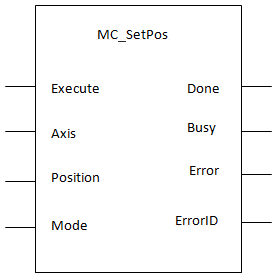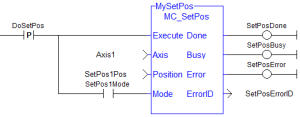![]()
 Function Block - Changes the present actual position of the axis (as reported by MC_ReadActPos) to the position specified by the Position and Mode inputs.
Function Block - Changes the present actual position of the axis (as reported by MC_ReadActPos) to the position specified by the Position and Mode inputs.
Inputs
|
Input |
Data Type |
Range |
Unit |
Default |
Description |
|---|---|---|---|---|---|
|
Execute |
BOOL |
FALSE, TRUE |
N/A |
No default |
On the rising edge, request to queue the change to the axis position. |
|
Axis |
AXIS_REF |
1 to 256 |
N/A |
No default |
Name of a declared instance of the AXIS_REF library function.
|
|
Position |
LREAL |
No range |
N/A |
No default |
Absolute Mode: New Axis Position to replace the present position. Relative Mode: Position offset to apply to present position. Typically used with multi-turn absolute position feedback devices. |
|
Mode |
BOOL |
FALSE, TRUE |
N/A |
No default |
LOW = Position input is an absolute position. HIGH = Position input is a relative position |
Outputs
|
Output |
Data Type |
Range |
Unit |
Description |
|---|---|---|---|---|
|
Done |
BOOL |
FALSE, TRUE |
N/A |
Indicates the reference move and position adjustment is complete. |
|
Busy |
BOOL |
FALSE, TRUE |
N/A |
Indicates this function block is executing. |
|
Error |
BOOL |
FALSE, TRUE |
N/A |
Indicates either:
|
|
ErrorID |
INT |
-32768 to +32767 |
|
Indicates the error if Error output is high. |
Remarks
-
-
This function or function block returns cached data.
See Program a Multi-Core Controller.
- See Function Blocks - General Rules about how inputs and outputs work.
- If a motor is associated with the axis, it does not move when MC_SetPos is executed.
- MC_SetPos does not cause any motion.
- It applies an offset to the command and actual positions.
- MC_SetPos sets the accumulated Superimposed distance value for the input axis to 0 (zero).
- See Axis Positions Data for more information.
- This function block replaces MC_SetPosition.
-
- This function block starts a motion-related action and stores data for calculations and error checking.
If using a dual-core controller, see Call Function Blocks Multiple Times in the Same Cycle.
Figure 1: MC_SetPos
FBD Language Example
Not available.
FFLD Language Example
-
- This function block finishes immediately.
Because of this, the Done output does not get set to FALSE in a second call to the same MC_SetPos instance unless there is an error.
If the application needs to look for a state change to determine if a particular call to MC_SetPos was successful, then useANDfor the rising edge of the Execute input, the Done output, and the inverse of the Error output.
This FFLD Language example shows how this can be done.
In the example, the SetPosSuccessful variable is set toTRUEfor one cycle upon a successful call to the MC_SetPos instance.
IL Language Example
Not available.
ST Language Example
(* MC_SetPos ST example *)
Inst_MC_SetPos ( Axis1 , 0, 0 );
//Inst_MC_SetPos is an instance of MC_SetPos function
(* MC_SetPos absolute mode example: Set position value to zero. *)
Inst_MC_SetPos ( Axis1 , 0, 0 );
//Inst_MC_SetPos is an instance of MC_SetPos function
(* MC_SetPos relative mode example: Increase position value by 1000. *)
Inst_MC_SetPos ( Axis1 , 1000, 1 );
//Inst_MC_SetPos is an instance of MC_SetPos function








